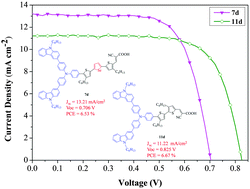Molecular engineering of starburst triarylamine donor with selenophene containing π-linker for dye-sensitized solar cells†
Abstract
A series of new D–π–A organic photosensitizers 7a–7d featuring a novel starburst electron donor unit and uncommon selenophene containing π-linker were synthesized, characterized, and applied for fabrication of dye-sensitized solar cells (DSSCs). Dyes 11d–13d with thiophene or phenyl ring as the π-linker also were synthesized for comparison. The best power conversion efficiency (PCE) of 6.67% was attained for 11d with a relatively high open-circuit voltage (Voc) of 0.825 V using conventional I−/I3− redox electrolyte in DSSCs, and this value reaches about 84% of the device based on standard dye N719 (7.91%) under the same device fabrication conditions. Electrochemical impedance spectroscopy (EIS) and open-circuit voltage decay (OCVD) were applied to verify the findings. All the results suggest that starburst electron donor design strategy can be used to minimize dye aggregation on TiO2 and to slow down the charge recombination kinetics in DSSCs to improve the photovoltaic performance. Effects of using selenophene as the π-linker building block on the photovoltaic parameters also were explored and evaluated.


 Please wait while we load your content...
Please wait while we load your content...